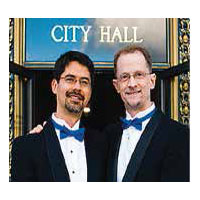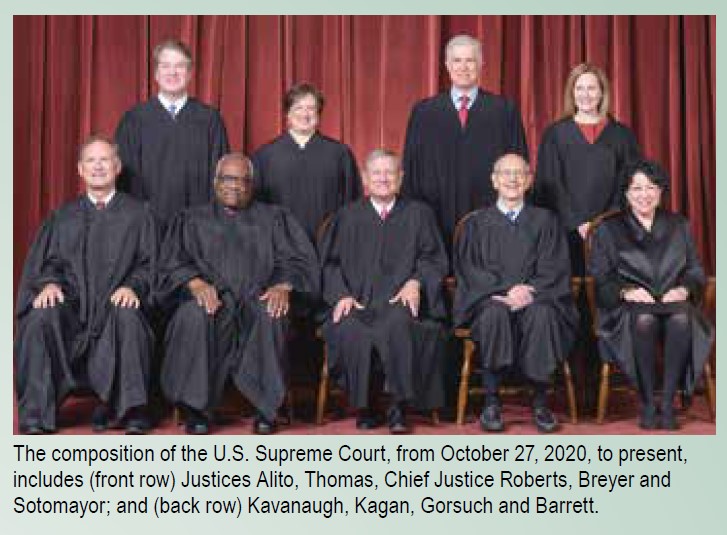
By Stuart Gaffney and John Lewis–
The night Donald Trump was elected president nearly five years ago, we remember asking each other in despair: Will conservative religious forces go to the U.S. Supreme Court to try to take away our marriage? Would there be an all-out attack on LGBTIQ rights at the Court?
Now that the Court has completed its first full term with a conservative supermajority of three Trump nominees, as well as two Bush, Jr., and one Bush, Sr., nominees, it’s time to assess where things stand today.
Bear in mind, had Hillary Clinton won the 2016 Electoral College vote (she easily won the popular vote), the Court would look very different today. It would have a solid pro-LGBTIQ majority of one Bill Clinton, two Obama, and two Hillary Clinton nominees. The blatantly partisan way Trump’s three appointees gained Senate confirmation and the fact that a single election can shape Constitutional interpretation for decades lay bare the need for institutional reform of the Court.
But nonetheless, all is not lost with the current Court, and in some instances there is even cause for hope.
For example, even as the Court failed to rule in favor of LGBTIQ rights last month in the foster parenting case (Fulton), it recognized that equal treatment of gay couples in foster-parenting was unquestionably a “weighty” interest. The Court reiterated language from a 2018 decision (Masterpiece Cake) that “[o]ur society has come to the recognition that gay persons and gay couples cannot be treated as social outcasts or as inferior in dignity and worth.” It seems that three liberal Justices (Breyer, Kagan, and Sotomayor) forged a compromise with three conservatives (Roberts, Kavanaugh, and Barrett) to issue a decision that resulted in the Catholic Social Services winning the case on narrow religious exception grounds particular to the case instead of a sweeping decision with far-reaching consequences.
The Court’s trend especially over the last year with its conservative supermajority to consistently find a way to rule in favor of conservative religious claims in cases it hears is disturbing. But only three Justices (Thomas, Alito, and Gorsuch) have urged a more aggressive approach in LGBTIQ cases, as they did in their Fulton concurrence last month.

Earlier this month they came together again to dissent to the Court’s decision not to hear the appeal of a Washington state florist who claimed that, because of her religion, she could violate state law by refusing to provide flowers for a lesbian couple’s wedding (Arlene’s Flowers). Significantly, neither Roberts, Kavanaugh, nor Barrett joined them in voting to take the case.
But last summer, Gorsuch broke with Thomas and Alito to author the Court’s landmark 6–3 Bostock decision, holding that employment discrimination against LGBTIQ people is unlawful sex discrimination prohibited by Title VII of the Civil Rights Act of 1964. Justice Ginsberg’s death reduced the vote margin by one, but the remaining five-Justice majority, which includes Chief Justice Roberts, ensures that Bostock is safe for now. It should have significant impact nationwide on LGBTIQ equality in housing, education, and health care, because parallel federal laws prohibit sex discrimination in those areas.
Many Court observers believe that the Court will someday address whether Title IX protections against sex discrimination apply to the right of transgender people to use the restroom that comports with their gender identity, an issue conservatives have used as a lightning rod wedge issue to motivate their political base and fundraise.
Although Kavanaugh joined Thomas and Alito dissenting in Bostock, he went out of his way to praise the “millions of gay and lesbian Americans [who] have worked hard for many decades to achieve equal treatment in fact and in law.” Will he now respect Bostock as precedent in future cases?
Remarks Barrett made in a 2016 speech before she became a justice cause us considerable concern as to how she might vote on the issue, but the 2020 Bostock decision now stands as precedent. When the Supreme Court last month refused to hear a Virginia county’s attempt to reverse courageous transgender youth Gavin Grimm’s victory in his multiyear battle regarding his right to use the bathroom at his high school, neither Barrett nor any of the other justices joined Thomas and Alito in voting to hear the case.
With respect to marriage equality, the departure of Justice Kennedy from the Court and the death of Justice Ginsberg mean that only three of the five justices who voted in favor of marriage equality in Obergefell remain on the Court: Breyer, Kagan, and Sotomayor. However, many believe based on a 2017 decision reaffirming Obergefell that Roberts now respects it as binding precedent even though he strongly dissented from the decision in 2015—and that Kavanaugh, Barrett, and hopefully Gorsuch do as well.
Thomas and Alito made national news last October when they blasted Obergefell in a statement upon the Court’s decision not to hear the case of the former Kentucky County clerk Kim Davis, who refused on religious grounds to issue marriage licenses to LGBTIQ couples. Neither Gorsuch, Roberts, nor Kavanaugh (Barrett was not yet on the Court) joined their vitriolic attack.
Recent polling shows that 70% of Americans support marriage equality and 83% support laws prohibiting discrimination against LGBTIQ people in employment, housing, and public accommodations. Our community and its millions of allies have created this dramatic societal embrace of equality. Our collective voice is what will sustain LGBTIQ rights at the Court.
Stuart Gaffney and John Lewis, together for over three decades, were plaintiffs in the California case for equal marriage rights decided by the California Supreme Court in 2008. Their leadership in the grassroots organization Marriage Equality USA contributed in 2015 to making same-sex marriage legal nationwide.
Published on July 29, 2021
Recent Comments